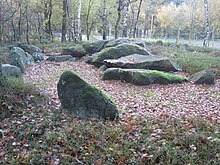Emsland Chamber

Emsland Chamber is the name given to the architecture of megalithic systems of the western group of the Funnel Beaker Culture (TBK), which existed between 3500 and 2800 BC. And occur on both sides of the Ems , in the Dutch province of Drenthe and in western (primarily on the Hümmling ) and central Lower Saxony ( Wildeshauser Geest ). The term relates to the structural features of passage graves . The passage grave is a form of Neolithic megalithic systems, which consists of a chamber and a structurally separated, lateral passage. This form is primarily found in Denmark, Germany and Scandinavia, as well as occasionally in France and the Netherlands. Neolithic monuments are an expression of the culture and ideology of Neolithic societies. Their origin and function are considered to be the hallmarks of social development.
The area between Havelte in the west, near Damme in the east, near Ganderkesee in the north and near Rheine in the south is, as far as the distribution of types is concerned, almost free of other construction methods. In the area of the western group of the TBK, in the Wildeshauser Geest or north of Papenburg, there is an architecture that is essentially different from the architecture used in the northern group of the TBK. The area around Osnabrück is a mixed region. The architecture is detached from the group-specific characteristics of the TBK group using it. Of these systems, around 200 have been preserved between the Weser and Ems and around 50 in the Drenthe.
description
The following features are typical of the Emsland chambers:
- The facilities are oriented east-west ( large stones from Stenum , Dötlinger Steingrab ). Werpeloh V makes one exception, one of the large stone graves on the Buschhöhe .
- The grave mound was sometimes surrounded by an oval or (or double-oval) stone wreath that was rounded at the ends and was located close to the chamber.
- The chambers are longer than usual in the TBK distribution area ( De hoogen Steener 28 m) with up to 17 cap stones, the number of which is often uneven. They are little deepened and double trapezoid in plan, whereby the (about two meters) wide sides of the trapezoids meet in the middle of the chamber and both ends are narrower, while in the rest of the north circle the opposite orientation occurs.
- The access is on the south side, where a particularly large capstone usually marks the center of the complex. The corridors are always short.
- There are no chambers with only one capstone.
The most important deviations from this are: The orientation can be northeast-southwest. There are single, one-sided trapezoidal, rectangular, recessed or short chambers ( devil's stones ). Occasionally hill borders lying at a greater distance and in two (preserved) cases, narrow but designed as a double oval. In the Netherlands almost all borders are missing, so that only the other criteria can be determined there.
Another form is the Holstein Chamber , which is a relatively short chamber, often with an eccentric entrance, within oversized ( Visbeker groom 104 m) rectangular enclosures, the so-called giant beds .
See also
literature
- Ekkehard Aner: The large stone graves of Schleswig-Holstein . In: Guide to prehistoric and early historical monuments 9, Mainz 1968
- Jan Albert Bakker : De Westgroep van de Trechterbekercultuur. Studies over chronologie en geografie van de makers van hunebedden endiepsteekceramiek, ten westen van de EIbe. Amsterdam 1973
- Jan Albert Bakker: The TRB West Group studies in the chronology and geography of the makers of hunebeds and Tiefstich pottery . 1979
- Hans-Jürgen Häßler (Ed.): Prehistory and early history in Lower Saxony . Stuttgart 1991
- Elisabeth Schlicht: Large stone graves in north-western Lower Saxony In: Heinz Schirnig (Ed.) Large stone graves in Lower Saxony Lax Hildesheim 1979 ISBN 3-7848-1224-4 p. 43 ff.
- Wolfgang Schlueter : The prehistory and early history of the city and the district of Osnabrück. Guide to prehistoric and prehistoric monuments. Vol. 42, Mainz 1979
Individual evidence
Web link
- Great stone grave route Emsland ( Memento from September 30, 2009 in the Internet Archive )
